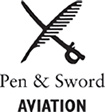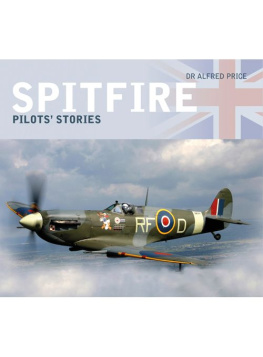
~ Contents ~
Plates appearing between
Line illustrations
There have been numerous books on the Spitfire, but in fact there still remains a great deal to be explored and explained about this iconic aircraft. In The Story of the Spitfire the author has certainly taken a new line by concentrating on the aircraft as an evolving fighting machine, and outlining the tactics and methods it employed in action. To strengthen his text he makes extensive use of official reports and summaries, plus first-person published and unpublished accounts by pilots who flew the Spitfire.
An important section in this book concerns the development of effective training courses to prepare RAF fighter pilots for combat. These were aimed at pilots flying all fighter types, not just the Spitfire, but as the war progressed the latter predominated. Making incremental improvements to the performance of the aircraft was all very well, but that counted for little if the pilots lacked the skills necessary to handle the aircraft in action. To the layman the business of training is less sexy than flying in combat, but the former is essential if the latter is to be performed effectively.
During the Battle of Britain in the summer of 1940, RAF Fighter Command suffered heavy losses in pilots. Some of the hastily trained replacements arrived at their operational squadrons with as little as ten hours flying in the type they were to take into action. These unfortunates found themselves at the bottom of an enormous learning curve. The lucky ones who survived their initial baptisms of fire would become effective in action, but that would take time.
Fortunately for Fighter Command, the large-scale daylight attacks on Great Britain tapered off in the autumn of 1940. That reduced the scale of its losses, removing the extreme pressure on squadrons to send inexperienced pilots into action. It also allowed time to pick through the hard-won lessons of combat, and put these to good use.
First and foremost, the increased time given to training was aimed at teaching pilots to survive in combat, to give them a sense of situational awareness that reduced their chance of being surprised by an attacking enemy. The majority of pilots shot down in fighter-versus-fighter combat never saw their assailant before their aircraft suffered hits. When they were likely to meet the enemy in the air, pilots were taught to scan the sky around their aircraft systematically, take a quick glance at the instrument panel to check all was well, then repeat the process.
Secondly, it was important to train pilots in air-to-air gunnery, to enable them to engage the enemy effectively. At the beginning of the Second World War, the gunnery training given to RAF fighter pilots varied between poor and non-existent. Ina series of incremental steps, it took until the middle of the war to make good this deficiency. Then the combat effectiveness of RAF fighter pilots increased markedly.
As Annexes the author includes a range of service trials reports produced by the RAFs Air Fighting Development Unit. These interesting warts and all documents reveal how well the different versions of the Spitfire compared with contemporary Allied and German fighter types.
The author describes the Spitfires employment in its various roles, as air superiority fighter, fighter-bomber, reconnaissance aircraft and as a navalised fighter to operate from aircraft carriers. Above all else, his account shows the amazing versatility of Reginald Mitchells original design to meet a specific RAF requirement for a short-range interceptor fighter.
Alfred Price
2007
~ Introduction:
Fighter Tactics-Principles ~
The world of fighter tactics is awash with accrued wisdom that provides a general basis for all fighter operations regardless of the aircraft type. This book concentrates on the tactical employment of the Spitfire in its air-to-air and air-to-ground roles and, whilst reference is made when appropriate to the accrued wisdom, this aspect is not the focus of attention. One of the great fighter pilots of the Second World War, A. G. Sailor Malan, learnt his trade flying Spitfires with 74 Squadron and in 1941 his Ten Rules of Air Fighting were circulated as guidance for fighter pilots. The ten rules were ones that would have been recognised by contemporary German aces such as Adolf Galland, and understood by First World War aces such as Albert Ball, although not all the rules were applicable in the same way in that earlier conflict; similarly, they could be found on the wall of an Israeli fighter squadron in the 1973 war with Egypt, and many would not be out of place in a modem air combat scenario, where all that has changed is the application of the same core principles.
Malans Rules of Air Fighting were:
1 Wait until you see the whites of his eyes. Fire short bursts of one or two seconds, and only when your sights are definitely ON.
2 Whilst shooting, think of nothing else, brace the whole of your body, have both hands on the stick, concentrate on your ring sight.
3 Always keep a sharp lookout, Keep your finger out!
4 Height gives you the initiative.
5 Always tum and face attack.
6 Make your decisions promptly. It is better to act quickly even though your tactics are not the best.
7 Never fly straight-and-level for more than thirty seconds in the combat area.
8 When diving to attack, always leave a proportion of your formation above to act as top guard.
9 INITIATIVE , AGGRESSION , AIR DISCIPLINE , and TEAMWORK are words that MEAN something in air fighting.
10 Go in quickly -punch hard -get out!
This is all good stuff but it does not provide a framework on which to assess the tactical capability of an aircraft. There are a number of factors that play a part in the success of any fighter aircraft; these can be summarised as:
1 Performance, primarily manoeuvrability.
2 Armament, which includes guns and gun sights.
3 Resilience to damage of the airframe, engine and systems.
4 Tactics, which includes leadership and training.
5 Pilot skill, meaning training rather than innate skill.
6 Luck.
Whilst the Ten Rules of Air Fighting provide a generic set of principles, it is hard to define any one of them in respect to a particular aircraft type, but by looking at the six factors mentioned above it is possible to provide both objective and subjective appraisals of an aircraft. However, this still does not provide a single appraisal of an aircraft since it is the combination of factors that gives the overall picture of capability invariably measured as success or failure. This can be summed up as the pilot with the best aircraft will not always win and the other factors, especially tactics and training, will mitigate the armchair result that statistics would otherwise predict.
The air fighting principles laid down by Sailor Malan were 100 per cent appropriate to the Spitfire pilot and his training should have been aimed at providing him with the skills, including what is now referred to assituational awareness to fight his aircraft in an effective and successful manner.
For example, as far as this book is concerned it is assumed that all fighter pilots of the period knew that they had to search the sky for the enemy and that to fly straight-and-level for more than a few seconds was a recipe for disaster. These are not specific Spitfire points; where they will be alluded to is in regard to aspects such as visibility from the cockpit, a major factor in successful lookout and one that was related to the airframe for the Spitfire this meant changes from the early canopy style with too much ironwork and limited visibility to a tear-drop canopy with a cut-down rear fuselage. Height was always seen as a major factor in air combat as it gave an initiative to an attacker, and again aircraft performance was a factor in this, both in terms of Service ceiling and climb time to height. This too is mentioned in the book where appropriate, and data on such performance can be found in the Annexes.
Next page















